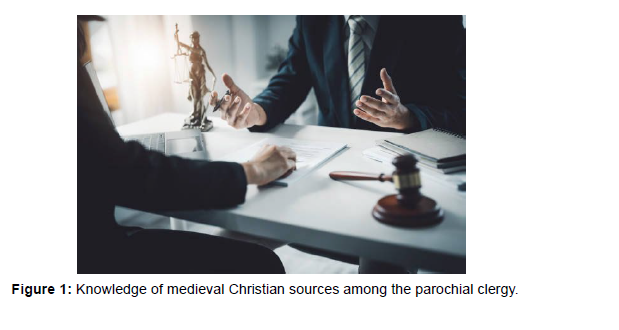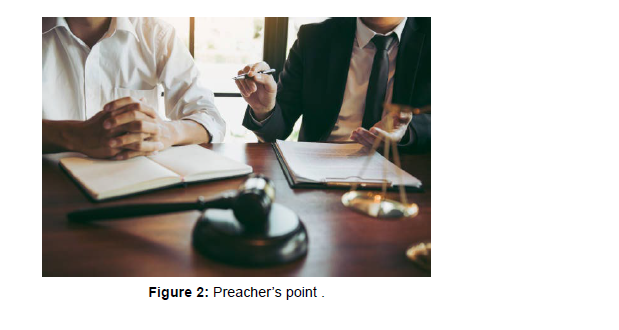Treads on Finding Inspiration for the Christianityâs Law Establishment
Received: 21-Aug-2023 / Manuscript No. JCLS-23-114798 / Editor assigned: 24-Aug-2023 / PreQC No. JCLS-23-114798 / Reviewed: 07-Sep-2023 / QC No. JCLS-23-114798 / Revised: 13-Sep-2023 / Manuscript No. JCLS-23-114798 / Published Date: 20-Sep-2023 QI No. / JCLS-23-114798
Abstract
The Age of Enlightenment’s signal achievement was to break the existing link between law and religion. Magisterial contribution to this volume explores the complexity of this subject. He shows that religion did remain a force to be reckoned with even among most Enlightenment thinkers. Subject to this amendment, does not deny the gradual impact of secularism on this subject. He would agree.
Keywords
Possible interpretations; Judicial opinions; Thoughtful consideration; Procedural rules; Medieval Christian; Religious freedom
Introduction
To many recent commentators the Christian religion appears to stand as an obstacle in the way of reaching desirable goals within their own systems of criminal law. Religious history replete with witch hunts and incineration of heretical dissenters is thought to be ample evidence of the wisdom of religion’s relegation to the side-lines of public life and penal law. Why, then, does it make any sense to produce a volume devoted to investigating the relationship between Christianity and the criminal law? And once produced, why should anyone read it? Answers to this objection are found in the chapters which follow, but it is worthwhile identifying some of the threads that tie them together [1]. Several good reasons exist for undertaking an investigation into the connections between crime and religion. Different sorts of readers will take an interest in the subjects found in this book’s chapters. Some of these interests will seem immediately obvious to most of us. Others require more thoughtful consideration of religion’s legitimate role in modern criminal law. While more challenging, they are also the more deserving of scholarly attention and thought. Several groups of potential readers will profit in an immediate way from the essays in this volume [2]. The first is made up of the men and women whose professional careers intersect with its subject’s religion and criminal law. The clergy are the most obvious members of this group. Virtually all Churches Catholic, Protestant and Orthodox have canons. They contain rules and legal principles touching offences and offenders. They establish court systems, enact procedural rules and provide definitions of both wrongful conduct and available remedies and penalties. Norman Doe’s chapter draws upon his own pioneering spade work in exploring this subject, and several other chapters in the volume add to what he has done [3].
Methodology
The mediaeval canon law’s treatment of criminal law provides an historical example. A good number of basic Western criminal law concepts of men’s area, and causation, as well as basic crimes against persons, property, religion and morality have roots in the medieval Christian sources and their antecedents in the first millennium [4]. A real need exists today for greater knowledge of this subject among the parochial clergy as shown in (Figure 1). Few would dispute that this knowledge is too often slight or even non-existent, and Doe’s chapter provides an attractive starting point. Not only that. The book’s utility may prove immediately useful to the clergy in several ways [5]. For instance, it provides an abundance of material that is of potential use to the clergy in their capacity as preachers. Some of it will enliven their sermons. To take just one example, includes the fascinating showing that today Adam might have been convicted of the English offence of scrumping. This is, at most, a misdemeanour, a minor infraction of the law, but the story in the Book of Genesis reminds us that God’s commands go beyond simple obedience to existing law [6].
Discussion
A comparison with Adam’s action and the modern law of scrumping will bring that point into dramatic focus. His fate will confirm the preacher’s point as shown in (Figure 2). Another group of professional men and women who will profit in an immediate way from the essays that follow are lawyers whose practice includes disputes in matters connected to religious life [7]. This has been a perennial field of contention, and it remains an area of litigation to this day. It sometimes seems to be growing in frequency and importance [8]. The laws of most Western countries guarantee religious freedom to its citizens [9]. What, then, happens when that freedom comes into conflict with secular laws? This is not a new question. It has a long history. Consider, for instance, the example and the effects of the fourteenth-century English statutes of Praemunire. They sought to curtail the Church’s freedom of action by restricting rights of appeal to the papal court. Crimes against the State addresses similar large questions which laws like this one now raise [10]. It is a continuing problem, one that involves conflicting but legitimate loyalties. His analysis begins, as does that of several another of the present authors, with the writings of St Augustine. The treatment of this subject by the ingenious Bishop of Hippo is not identical with what today’s analysis will yield, but the chapter demonstrates both how old the question is and how varied Christian responses to it have been [11]. Augustine also still has something of value to say about the legal treatment of the conflicts that arise, and this volume provides a ready entry into his thought on the subject [12]. A further group of readers who will find subjects of immediate utility in this volume’s chapters consists of the students and teachers in universities and law schools that offer courses and seminars in law and religion. This has become a growing field of study [13]. No surveyor’s list attempts to distinguish between the nominal and the serious. The latter cannot be an empty category, however, and the chapters that follow will interest its members in several ways. Lord Judge’s Preface to this volume is testimony to the interest the contents of this volume have had for him, and his is only one example among many [14]. There are readers who have found and will find interest in the intersection of past and present thought about crime and religion. What is laid out in the books of the Bible and is explored in the works of interpreters of Scripture is capable of deepening the faith of religious men and women. Likewise, the second of Nathan Chapman’s chapters, which concludes the volume, raises questions over the participation of Christians in matters of governmental judgment, from in the faith that God uses human judgment. What better note on which to finish but to return to the profoundly theological questions which are ever-present in the intersection of Christianity and the criminal law, which will continue to be asked in the current and future generations [15].
Conclusion
Making a causal connection between our criminal law and religious commands is a habit we are widely regarded as having outgrown. Time and opinion move on. Religion now belongs within the private side of modern lives, not the public world of courts and crime.
Acknowledgement
None
Conflict of Interest
None
References
- Hassan A, Qadri MA, Saleem M (2021)The Muslim Family Law Ordinance 1961: Pioneer of Women Empowerment in Pakistan.JRSP PAK 58:1-8.
- Abdullah R, Monsoor T, Johari F (2015) Financial support for women under Islamic family law in Bangladesh and Malaysia. Taylor and Francis UK 21:363-383.
- Shahid TN (2013) Islam and women in the constitution of Bangladesh: The impact on family laws for Muslim women.FLJS UK:1-11.
- Shehabuddin E (2008) Reshaping the holy: Democracy, development, and Muslim women in Bangladesh.CUP NY: 1-304.
- Hossain K(2003) In Search of Equality: Marriage Related Laws for Muslim Women in Bangladesh.J IntWomen's Stud MA 5:1-38.
- Hassan A, Qadri MA, Saleem M (2021)The Muslim Family Law Ordinance 1961: Pioneer of Women Empowerment in Pakistan.JRSP PAK 58:1-8.
- Abdullah R, Monsoor T, Johari F (2015) Financial support for women under Islamic family law in Bangladesh and Malaysia. Taylor and Francis UK 21:363-383.
- Shahid TN (2013) Islam and women in the constitution of Bangladesh: The impact on family laws for Muslim women.FLJS UK:1-11.
- Shehabuddin E (2008) Reshaping the holy: Democracy, development, and Muslim women in Bangladesh.CUP NY: 1-304.
- Hossain K(2003) In Search of Equality: Marriage Related Laws for Muslim Women in Bangladesh.J IntWomen's Stud MA 5:1-38.
- Stebek EN (2018) Consumer protection law in Ethiopia: The normative regime and the way forward. J Consum Policy US 41:309-332.
- Dawar K, Ndlovu N (2018) A comparative assessment of competition in Africa: Identifying drivers of reform in Botswana, Ethiopia, and Nigeria. J Antitrust Enforc OUP UK 6:150-172.
- Stebek EN (2017) Deliverables and pledges under Ethiopian Trade Competition Law: the need for private sector empowerment and enablement.Miz L Rev EA 11:1-32.
- Bokoro HL (2020) Trade remedy laws in Ethiopia: A critical Review. IJHSS IN 25(10):49-55.
- Hopkins N, Vered KH (2010). Minority group members' theories of intergroup contact: A case study of British Muslims' conceptualizations of Islamophobia and social change. Br J Soc Psychol UK 45:245-264.
Indexed at, Google Scholar, Crossref
Indexed at, Google Scholar, Crossref
Indexed at, Google Scholar, Crossref
Indexed at, Google Scholar, Crossref
Indexed at, Google Scholar, Crossref
Indexed at, Google Scholar, Crossref
Indexed at, Google Scholar, Crossref
Citation: Heleba S (2023) Treads on Finding Inspiration for the Christianity’s LawEstablishment. J Civil Legal Sci 12: 398.
Copyright: © 2023 Heleba S. This is an open-access article distributed under theterms of the Creative Commons Attribution License, which permits unrestricteduse, distribution, and reproduction in any medium, provided the original author andsource are credited.
Select your language of interest to view the total content in your interested language
Share This Article
Recommended Journals
Open Access Journals
Article Usage
- Total views: 1316
- [From(publication date): 0-2023 - Dec 20, 2025]
- Breakdown by view type
- HTML page views: 993
- PDF downloads: 323


